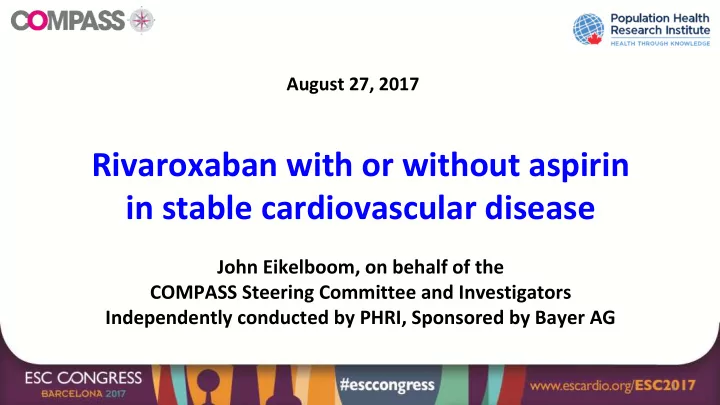

August 27, 2017 Rivaroxaban with or without aspirin in stable cardiovascular disease John Eikelboom, on behalf of the COMPASS Steering Committee and Investigators Independently conducted by PHRI, Sponsored by Bayer AG 1
2
Background • CV disease affects 4% of world population (300 million persons) • Aspirin is the single most widely used preventive treatment but produces only a 19% RRR during the long term • Warfarin with or without aspirin is more effective than aspirin but increases bleeding, including intracranial hemorrhage • Rivaroxaban is safer than warfarin and reduces mortality in patients with recent acute coronary syndrome 3
Objectives To determine in stable CV disease, whether: • Rivaroxaban 2.5 mg bid + aspirin 100 mg od, or • Rivaroxaban 5 mg bid reduces CV death, stroke or myocardial infarction compared with aspirin 100 mg od And whether: • Pantoprazole compared with placebo reduces upper GI events (ongoing) 4
COMPASS design Stable CAD or PAD 2,200 with a primary outcome event Rivaroxaban 2.5 mg bid + aspirin 100 mg od Rivaroxaban 5 mg bid Expected follow up R 3-4 years Run-in Aspirin 100 mg od (aspirin) 5
Outcomes • Primary – CV death, stroke or myocardial infarction • Secondary – CHD death, ischemic stroke, myocardial infarction, or acute limb ischemia, – CV death, ischemic stroke, myocardial infarction, or acute limb ischemia, – Mortality • Safety and net clinical benefit – ISTH major bleeding (modified) – Primary plus fatal or critical organ bleeding 6
602 sites, 33 countries Czech Republic N=1553 Italy N=1018 7
Follow up, adherence • On February 6, 2017 the Data and Safety Monitoring Board recommended discontinuation of rivaroxaban/aspirin arms for clear evidence of efficacy (combination: Z= -4.59, P<0.00001; rivaroxaban: Z= -2.44, P=0.01) • Close-out between March and June 2017 • Mean follow up 23 months • Follow up 99.8% complete 8
Baseline characteristics Rivaroxaban + aspirin Rivaroxaban Aspirin Characteristic N=9,152 N=9,117 N=9,126 Age, yr 68 68 68 Blood pressure, mmHg 136/77 136/78 136/78 Total cholesterol, mmol/L 4.2 4.2 4.2 CAD 91% 90% 90% PAD 27% 27% 27% Diabetes 38% 38% 38% Lipid-lowering 90% 90% 89% ACE-I or ARB 71% 72% 71% 9
Primary: CV death, stroke, MI R + A R A Rivaroxaban + aspirin Rivaroxaban N=9,152 N=9,117 N=9,126 vs. aspirin vs. aspirin Outcome N N N HR HR p p (%) (%) (%) (95% CI) (95% CI) CV death, 379 448 496 0.76 0.90 <0.0001 0.12 stroke, MI (4.1%) (4.9%) (5.4%) (0.66-0.86) (0.79-1.03) 10
Primary: CV death, stroke, MI 11
Primary components R + A A Rivaroxaban + Aspirin N=9,152 N=9,126 vs. Aspirin Outcome N N HR p (%) (%) (95% CI) 160 203 0.78 CV death 0.02 (1.7%) (2.2%) (0.64-0.96) 83 142 0.58 Stroke <0.0001 (0.9%) (1.6%) (0.44-0.76) 178 205 0.86 MI 0.14 (1.9%) (2.2%) (0.70-1.05) 12
Secondary outcomes R + A A Rivaroxaban + Aspirin N=9,152 N=9,126 vs. Aspirin Outcome N N HR P* (%) (%) (95% CI) CHD death, IS, 329 450 0.72 <0.0001 MI, ALI (3.6%) (4.9%) (0.63-0.83) CV death, IS, 389 516 0.74 <0.0001 MI, ALI (4.3%) (5.7%) (0.65-0.85) 313 378 0.82 Mortality 0.01 (3.4%) (4.1%) (0.71-0.96) * pre-specified threshold P=0.0025 13
CAD and PAD Subgroups for primary outcome R + A A Rivaroxaban + Aspirin N=9,152 N=9,126 vs. Aspirin Outcome N N HR (%) (%) (95% CI) 347 460 0.74 CAD (4.2%) (5.6%) (0.65-0.86) 126 174 0.72 PAD (5.1%) (6.9%) (0.57-0.90) 14
Major bleeding R + A R A Rivaroxaban + Aspirin Rivaroxaban N=9,152 N=9,117 N=9,126 vs. Aspirin vs. Aspirin Outcome N N N HR HR P P (%) (%) (%) (95% CI) (95% CI) 288 255 170 1.70 1.51 Major bleeding <0.0001 <0.0001 (3.1%) (2.8%) (1.9%) (1.40-2.05) (1.25-1.84) 15 14 10 1.49 1.40 Fatal 0.32 0.41 (0.2%) (0.2%) (0.1%) (0.67-3.33) (0.62-3.15) 21 32 19 1.10 1.69 Non fatal ICH* 0.77 0.07 (0.2%) (0.4%) (0.2%) (0.59-2.04) (0.96-2.98) 42 45 29 1.43 Non-fatal other 1.57 0.14 0.06 (0.5%) (0.5%) (0.3%) (0.89-2.29) critical organ* (0.98-2.50) * symptomatic 15
Net clinical benefit R + A A Rivaroxaban + Aspirin N=9,152 N=9,126 vs. Aspirin Outcome N N HR P (%) (%) (95% CI) Net clinical benefit 431 534 0.80 (Primary + Severe bleeding 0.0005 (4.7%) (5.9%) (0.70-0.91) events) 16
Conclusion Rivaroxaban 2.5 mg bid plus aspirin 100 mg od: • Reduces CV death, stroke, MI • Increases major bleeding without a significant increase in fatal, intracranial or critical organ bleeding • Provides a net clinical benefit No significant benefit of rivaroxaban alone 17
Acknowledgments Steering Committee: S. Yusuf (Chair), K. Fox (Co-Chair), S. Connolly (Co-PI), JW. Eikelboom (Co-PI), J. Bosch (Study Director), V. Aboyans, M. Alings, S. Anand, A. Avezum, D. Bhatt, K. Branch, P. Commerford, N. Cook-Bruns, G. Dagenais, A. Dans, R. Diaz, G. Ertl, C. Felix, , T. Guzik, J. Ha, R. Hart, M. Hori, A. Kakkar, K. Keltai, M. Keltai, J. Kim, A. Lamy, F. Lanas, B. Lewis, Y. Liang, L. Liu, E. Lonn, P. Lopez-Jaramillo, A. Maggioni, K. Metsarinne, P. Moayyedi, M. O'Donnell, A. Parkhomenko, L. Piegas, N. Pogosova, J. Probstfield, L. Ryden, M. Sharma, P.G. Steg, S. Stoerk, A. Tonkin, C. Torp-Pedersen, J. Varigos, P. Verhamme, D. Vinereanu, P. Widimsky, K. Yusoff, J. Zhu We thank all investigators, study coordinators and participants 18
Recommend
More recommend